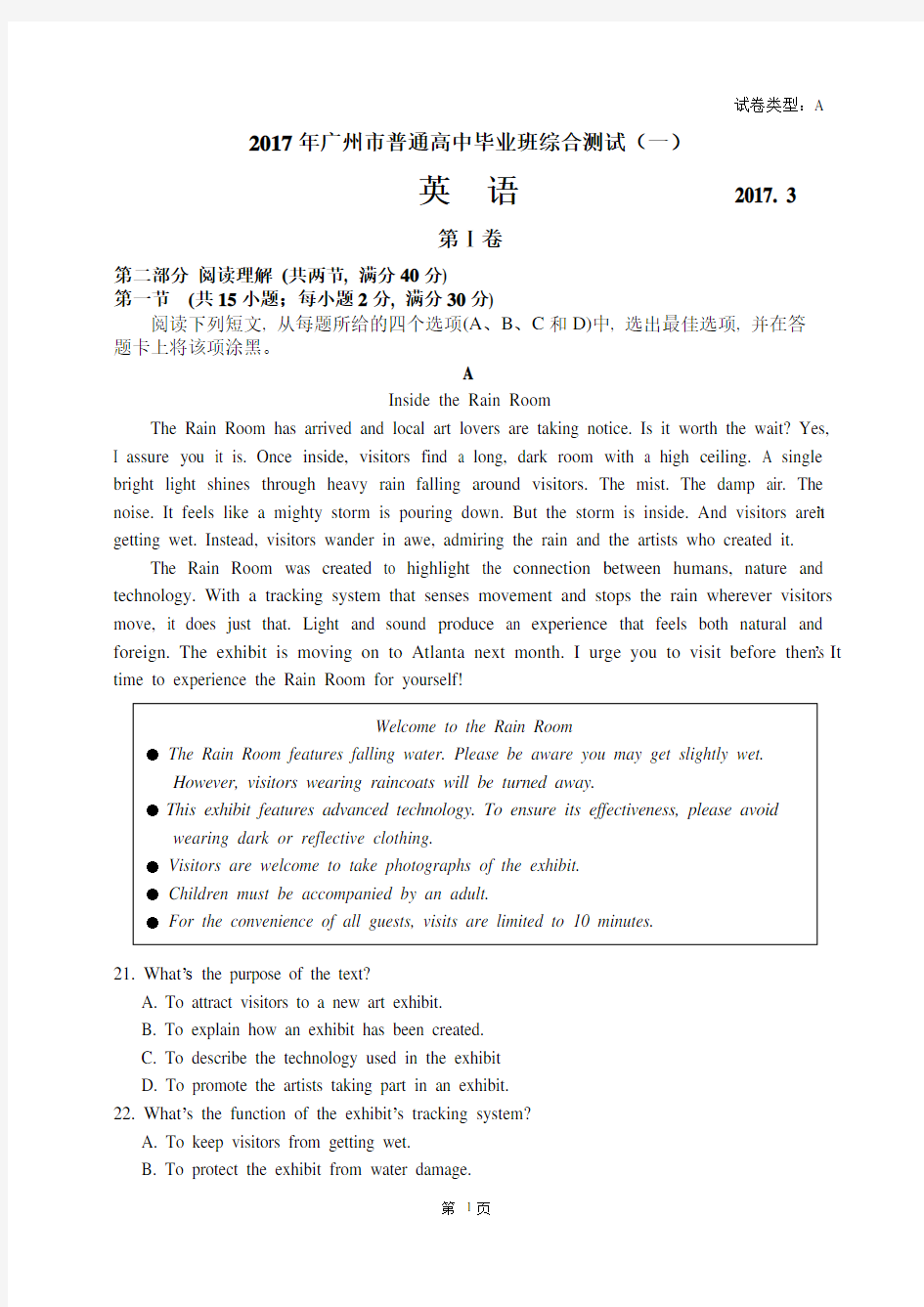
2017年广州一模英语试题及答案(精校版)
- 格式:doc
- 大小:98.00 KB
- 文档页数:10


试卷类型:A 2017年广州市普通高中毕业班综合测试(一)
英语2017. 3
第Ⅰ卷
第二部分阅读理解(共两节, 满分40分)
第一节(共15小题;每小题2分, 满分30分)
阅读下列短文, 从每题所给的四个选项(A、B、C和D)中, 选出最佳选项, 并在答
题卡上将该项涂黑。
A
Inside the Rain Room
The Rain Room has arrived and local art lovers are taking notice. Is it worth the wait? Yes, I assure you it is. Once inside, visitors find a long, dark room with a high ceiling. A single bright light shines through heavy rain falling around visitors. The mist. The damp air. The noise. It feels like a mighty storm is pouring down. But the storm is inside. And visitors aren’t getting wet. Instead, visitors wander in awe, admiring the rain and the artists who created it.
The Rain Room was created to highlight the connection between humans, nature and technology. With a tracking system that senses movement and stops the rain wherever visitors move, it does just that. Light and sound produce an experience that feels both natural and foreign. The exhibit is moving on to Atlanta next month. I urge you to visit before then. It’s time to experience the Rain Room for yourself!
21. What’s the purpose of the text?
A. To attract visitors to a new art exhibit.
B. To explain how an exhibit has been created.
C. To describe the technology used in the exhibit
D. To promote the artists taking part in an exhibit.
22. What’s the function of the exhibit’s tracking system?
A. To keep visitors from getting wet.
B. To protect the exhibit from water damage.
C. To time how long visitors are in the room.
D. To count the number of visitors in the room.
23. What must you do when visiting the Rain Room?
A. Wear a raincoat.
B. Wear dark clothing.
C. Leave your camera outside
D. Pass through within 10 minutes
B
Dujiangyan is the oldest man-made water system in the world, and a wonder in the development of Chinese science. Built over 2,200 years ago in what is now Sichuan Province in Southwest China, this amazing engineering achievement is still used today to irrigate over 6,000 square kilometres of farmland, take away floodwater and provide water for 50 cities in the province.
In ancient times, the region in which Dujiangyan now stands suffered from regular floods caused by overflow from the Minjiang River. To help the victims of the flooding, Li Bing, the region’s governor, together with his son, decided to find a solution. They studied the problem and discovered that the river most often overflowed when winter snow at the top of the nearby Mount Yulei began to melt as the weather warmed.
The simplest fix was to build a dam, but this would have mined the Minjiang River. So instead Li designed a series of channels built at different levels along Mount Yulei that would take away the floodwater while leaving the river flowing naturally. Better still, the extra water could be directed to the dry Chengdu Plain, making it suitable for farming.
Cutting the channels through the hard rock of Mount Yulei was a remarkable accomplish- ment as it was done long before the invention of gunpowder and explosives. Li Bing found another solution. He used a combination of fire and water to heat and cool the rocks until they cracked and could be removed. After eight years of work, the 2-metre-wide canals had been carved through the mountain.
Once the system was finished, no more floods occurred and the people were able to live peacefully and affluently. Today, Dujiangyan is admired by scientists from around the world because of one feature. Unlike modern dams where the water is blocked with a huge wall, Dujiangyan still lets water flow through the Minjiang River naturally, enabling ecosystems and fish populations to exist in harmony.
24. What are the benefits of Dujiangyan according to the first paragraph?
A. Reducing flooding and watering farmland.
B. Protecting the mountain and reducing flooding.
C. Watering farmland and improving water quality.
D. Drying the river and supplying cities with water.
25. What was the main cause of the Minjiang River’s flooding?
A. Heavy rains.
B. Melting snow.
C. Low river banks.
D. Steep mountains.